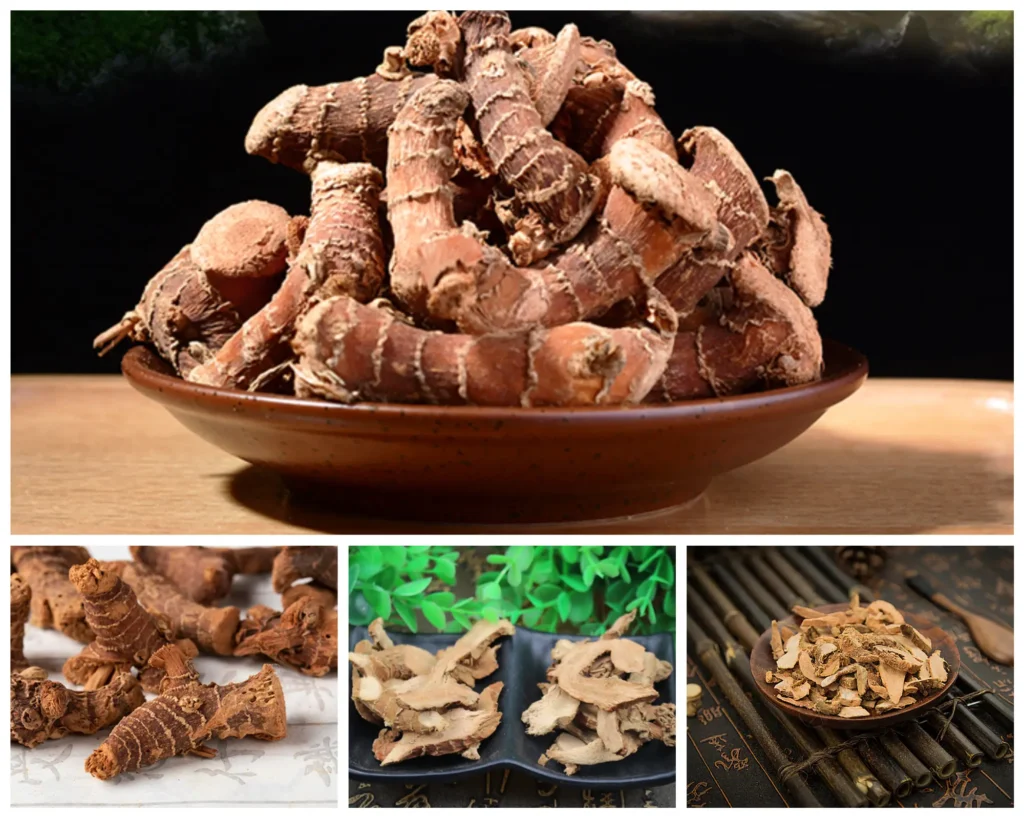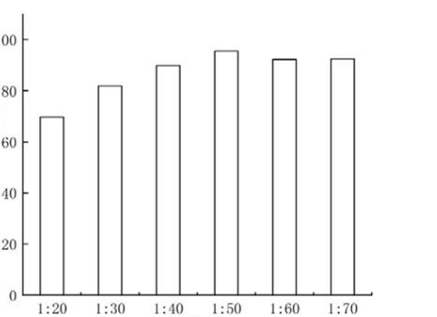Abstract
1. Main Functions of Alpinia officinalis Polysaccharides
A. Antioxidant
- Protects against oxidative damage and improves cognitive function.
- Reduces lipid peroxides and increases antioxidant enzyme activities.
B. Anticancer
- Induces apoptosis in cancer cells.
- Activates apoptotic proteinases and disrupts cancer cell growth.
C. Hypoglycemic
- Lowers blood sugar levels and increases insulin sensitivity.
- Reduces inflammatory markers and stimulates insulin secretion.
D. Antibacterial
- Effective against Staphylococcus aureus and other Gram-positive bacteria.
- Synergistic effect with antibiotics like gentamicin.
2. Suitable Supplement Forms for Alpinia officinalis (Galangal)
- Capsules
- Tablets
- Powders
- Liquid Extracts
- Essential Oils
- Pressed Candies
- Selenium-rich Tea
- Health Teas
- Health Wines
3. Market Prospects/Advantages
- High Demand: Growing demand for galangal in both medicinal and food markets.
- Wide Applications: Used in medicinal products and as a spice.
- Expanding Market: Potential for high-end products like teas, essential oils, and health candies.
- International Recognition: Increasingly recognized in the US, EU, and Southeast Asia.
4. Extraction Methods
- Solvent Extraction: Isolates active components.
- Enzyme Method: Extracts functional components with high purity.
- Column Chromatography: Purifies extracts for high purity.
- Ultrafiltration: Preserves polysaccharide structure.
- Alcohol Precipitation: Fractionates polysaccharides.
5. Common Specifications
- Purity Levels: High concentrations of active ingredients.
- Molecular Weights: Specific weights for different polysaccharide fractions.
- Formulations: Available in powders, extracts, and hydrolysates.


Article Content
Galangal is a perennial herbaceous plant of the genus Alpinia in the Zingiberaceae family, also known as Galangal. It is mainly distributed in Southeast Asia, including southern China, India, Indonesia, Malaysia and Thailand. The dried rhizome of Galangal is an important southern medicine, widely grown in these places and used in traditional medicine and cooking. In China, the Ministry of Health announced in 1998 that Galangal is a natural plant that is both a food and a medicine, and is an important ingredients for the development of new health products and functional foods. According to the 2010 edition of the "Chinese Pharmacopoeia", it has the effects of warming the stomach and dispersing cold, digesting food and relieving pain, and is used for symptoms such as cold pain in the abdomen, stomach cold vomiting, belching and acid swallowing. Due to the wide range of uses of Galangal, it has been widely planted in Guangdong, Guangxi and Hainan in China in recent years. Galangal is rich in flavonoids, diarylheptanes and terpenoids, and has important research and development value. Galangin is a polyphenolic flavonoid found in Galangal and propolis. Studies have found that it has antioxidant, anti-obesity, antiviral and anti-inflammatory properties. In addition, experimental evidence has shown that galangal can exert anti-inflammatory effects through the NF-κB/MAPK pathway.
1.Efficacy of galangal polysaccharides
A.Antioxidant
The phenolic substance protocatechuic acid isolated from the dried fruit by researchers has a protective effect on the oxidative damage of PC12 cells caused by H2O2, can improve the cognitive ability of older mice, reduce the content of lipid peroxides, and increase the activity of glutathione peroxidase and superoxide dismutase. In addition, the ethanol extract of galangal has high antioxidant activity under neutral conditions, relatively weak antioxidant effect under acidic conditions, and the antioxidant activity increases with increasing concentration in the range of 0.10-1.0 mg/ml. In addition, its ethanol extract also shows a strong scavenging effect of peroxide anions, and the chelation and reduction of Fe2+ can be used as a free radical scavenger and lipid peroxidation inhibitor. Studies have found that galangal dry powder has stronger antioxidant activity than its ethanol extract.
B.Anticancer
Alpinia officinalis ethanol extract can induce apoptosis of human KB cancer cells. Treatment of human KB cells with different concentrations of ethanol extract of Alpinia officinalis can lead to the disappearance of cell growth ability, morphological changes, and nucleosomal DNA breakage. Further studies have shown that its mechanism of action is that Alpinia officinalis extract can cause the disappearance of mitochondrial membrane potential, cytochrome C translocation, activation of apoptotic proteinase-3 and apoptotic proteinase-9, and degradation of polynucleoside diphosphate ribose polymerase.
C.Hypoglycemic
Alpinia officinalis extract has a certain hypoglycemic effect. In the hypoglycemic experiment of normal male New Zealand rabbits, the researchers found that oral administration of 3g/kg of Alpinia officinalis powder can significantly reduce blood sugar, and the hypoglycemic effect of methanol extract and water extract is more obvious. When the oral dose is 4g/kg, blood sugar is significantly reduced after 8h. It is speculated that its hypoglycemic effect may be achieved by promoting the secretion of insulin by the pancreas in the body.
D.Antibacterial
The study found that the combination of galangin and gentamicin has a synergistic effect on methicillin-resistant Staphylococcus aureus. When studying the antibacterial effect of Alpinia officinalis on Staphylococcus aureus, it was found that D,L-1'-acetoxychavicol acetate in the ethanol extract of Alpinia officinalis has strong antibacterial activity against Staphylococcus aureus, and Gram-positive bacteria, especially Staphylococcus and yeast, are also sensitive to it. At the same time, studies have found that 40% ethanol extract of Alpinia officinalis can inhibit Staphylococcus aureus, alpha-hemolytic Streptococcus, β-hemolytic Streptococcus and Streptococcus pneumoniae. These activities are related to its inhibitory effect on β-ketoacyl-ACP reductase.
2.Product Application and Dynamics
Alpinia galanga is a kind of medicine and food, of which the amount used for medicine accounts for about one-tenth of the total demand. It is mainly used in the seasoning and spice market. For example, the commonly used seasoning "Thirteen Spices" in China contains galanga. In China, the annual demand for galanga is about 7,000 tons. The output in 2023 is expected to be only about 70% of the demand. In addition to social inventory, China alone is expected to have a demand gap of about 10%-15%. In addition to the gap in ingredients for supplements, it is speculated that galanga is likely to continue to refresh historical prices in the future.
Alpinia galanga has very high medical and food value and is widely used. Galanga is a key medicinal ingredient in the best-selling Wei Yan Kang Capsules, Wei Bing Pills, Wei Tai Capsules, Tiao Wei Dan, Toothache Medicine, etc., and even the hot pot base, seasonings, health teas, and health wines that we often eat can often find galanga. In the future, galangal is expected to further expand its application market, such as galangal selenium-rich tea, galangal essence, galangal pure essential oil, galangal pressed candy, etc. In the past, galangal, which was always dry and wrinkled on the market, will be expected to "transform" into a series of "high-end" deep-processed products.
3.Market prospects
Alpinia officinalis is a natural plant that is both a food and a medicine announced by the Ministry of Health of China in 1998. It is an important raw material for the development of new health products and functional foods. As the health benefits of galangal are verified by more and more scientific research, galangal is becoming more well-known internationally, especially in the following aspects:
Traditional medicine: Galangal has a long history of use in Chinese medicine and Indian Ayurvedic medicine. As an important herb, it has many health benefits, such as anti-inflammatory, antibacterial, and digestive.
Food and spices: In the international culinary world, galangal is popular for its unique spicy and aromatic taste and is often used in Southeast Asian dishes.
Modern research: In recent years, more research has been conducted on the polysaccharide components of galangal and its health benefits, further enhancing its popularity in the scientific community. Its international recognition is also gradually increasing, especially in the following countries and regions:
- United States: In the dietary supplement market, products containing galangal ingredients are popular and are included in many natural health products.
- EU countries: Galangal and its polysaccharide components are also recognized and used in some EU countries, especially in the field of natural medicine and health products.
- Southeast Asian countries: As the origin of galangal, Southeast Asian countries have a wide range of recognition and application of it, not only in traditional medicine but also in the modern health products market.
4.Current status of production technology
At present, the edible and medicinal value of galangal roots has received great attention, but there is very little research on the aboveground part of galangal. The stems and leaves are directly discarded during collection, resulting in a waste of resources. Practice has proved that galangal stems and leaves have very good antioxidant and hypoglycemic biological activities. The extract contains rich active substances such as flavonoids and polysaccharides. The main component of flavonoid compounds is galangin, which has high research value and development and utilization prospects. However, due to the current neglect of galangal stems and leaves as a raw material, the functional components have not been extracted and utilized, which makes the processing and extraction technology of active substances in galangal stems and leaves insufficient.


Horizontal axis represents: component-liquid ratio
Vertical axis represents: extraction amount (mg/g)
5.Introduction to the scientific achievements of scientists
The purpose of this study is to overcome the shortcomings of the existing processing and extraction technology of active substances in the stems and leaves of Alpinia galanga, and to provide a method for separating and purifying the stem and leaf extracts of Alpinia galanga. The crushed stems and leaves of Alpinia galanga are used as raw materials, and the functional components are extracted by solvent extraction or enzyme method, and the functional components are separated and purified by column chromatography, and finally the stem and leaf extracts of Alpinia galanga are obtained. The obtained stem and leaf extracts of Alpinia galanga are of high purity and have a good hypoglycemic effect. The inhibition rate of the unpurified crude extract on the activity of α-amylase is 51.93%, and the inhibition rate of the purified functional component solution on the activity of α-amylase can reach 90.11%, which can be used to prepare hypoglycemic drugs or health products. The column chromatography method used in the study has the advantages of stable physical and chemical properties, strong selective adsorption, mild desorption conditions, easy regeneration, and long service life. However, due to the wide variety of resins in column chromatography and the different mechanisms of chromatographic separation, it is necessary to select the most suitable resin for the separation object in order to achieve the purpose of effective separation. In this method, for the galangal stem and leaf extract, a resin with certain adsorption selectivity, easy adsorption process, large adsorption capacity and easy desorption is selected, and the optimal column chromatography processing conditions are explored, so that the galangal stem and leaf extract finally prepared has high purity and no obvious impurities. The preparation process of this method is simple, the process parameters are easy to control, and the neglected and wasted galangal stems and leaves are effectively utilized. The production raw materials are widely available, effectively filling the gap in the development and utilization of galangal stems and leaves, and have high social and economic value.


